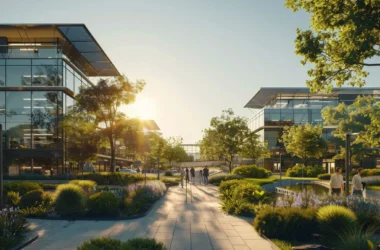As concerns about climate change and dwindling natural resources grow, our endeavours are becoming more geared toward minimising our negative impact on the environment.
Due to increasing carbon emissions in cities worldwide, it makes sense that businesses are looking for ways to reduce their carbon footprint, too.
One of the more exciting ways a business can reduce its carbon footprint is to create a green space on a commercial roof. Let’s discuss what a green roof is and how it can benefit businesses and the environment.
What Is a Green Roof?
A green roof is essentially a rooftop garden. Green or living roofs are established on commercial buildings that have a flat or pitched roof.
A substrate that can support vegetation is laid directly over the waterproof membrane on the roof of a building. This acts as the growing medium for plants.
But did you know that this kind of urban greening doesn’t only lower a building’s carbon footprint?
Green roofs also support agriculture, encourage biodiversity, benefit the community, and can lower utility costs.
The Environmental Benefits of Green Roofs
As commercial buildings increasingly take up more space and replace natural habitats, it makes sense to utilise the space we have created in practical and meaningful ways.
Green building design trends are changing the way we interact with the environment. Although this symbiotic relationship is not the complete solution to climate change, it’s an integral part of the process.
Reduced Air Pollution and Greenhouse Gases
Green roofs reduce greenhouse gases because they lower energy consumption requirements – specifically air conditioning.
One square meter of a green roof can absorb 5kg of CO2 every year.
The vegetation on green roofs also acts as a filter for airborne particles. Plants remove harmful compounds like smog and heavy metals from the air we breathe.
Just one square meter of a green roof can filter 0.2kg of airborne particles out of the air every year.
Promoting Biodiversity
Green roofs encourage biodiversity by creating habitats for flora and fauna. Additionally, they can be designed to provide food and shelter for insects, small mammals, and birds.
Green roofs increase the populations of urban pollinators like bees by providing alternative habitats.
How Green Roofs Save Businesses Money
If the environmental impact of urbanisation isn’t enough of an incentive to make green roofs the norm, they also have economic, social, and environmental benefits. Let’s discuss them in detail.
The Concrete Jungle is Actually a Heat Island
The construction of multiple tall buildings reduces vegetation in the area and inhibits natural cooling processes such as evapotranspiration.
Additionally, buildings reflect and radiate solar energy that does not completely dissipate during the day. This leads to the urban ‘heat island’ effect in cities.
The difference in temperature between a large city and the surrounding countryside can be 2.7 degrees Celsius (5 degrees Fahrenheit) during the day and as high as 12 degrees Celcius (22 degrees Fahrenheit) at night.
Naturally, higher temperatures increase the demand for interior air conditioning in buildings.
The evaporation of water from the plants and growing medium on a green roof naturally cools the air around a building and lowers the ambient temperature.
As a bonus, a green roof provides thermal insulation, which means it will also insulate a building against lower temperatures.
A green roof can reduce air conditioning use in a building by as much as 75%.
They Prevent Leaks
In all buildings, waterproof membranes need to be inspected and maintained regularly to ensure that there are no leaks.
Water leaks in a building can lead to major problems, such as mould and structural damage. Leaks can also cause electricity shorts, which can become deadly fire hazards.
A green roof protects a building’s waterproof membrane by shielding it from harmful UV rays and extreme temperature changes.
On average, a green roof will triple the lifespan of a building’s waterproof membrane.
They Store Water More Efficiently
We often take water for granted, but it is one of our most precious natural resources.
Green roofs can reduce the energy required to process water by decreasing the runoff collected in stormwater drains.
They can also create a self-sufficient water collection system – rainwater can be collected during the rainy season, purified, and redistributed.
The natural drainage from a green roof also saves money on drain inspection, installation and maintenance.
They Increase Property Value
Existing green roofs can increase property value due to shifting attitudes in individuals and government. Businesses are increasingly required to adapt to more sustainable modes of energy consumption. Green roofs can also generate income as leisure spots.
How Green Roofs Benefit the Community
Green roofs and green spaces in urban environments can benefit the community in practical and psychological ways.
They Promote Urban Agriculture
Rooftop farms are becoming increasingly popular because the importance of growing food in underutilised spaces is becoming a worldwide priority.
Rooftop farming is highly viable. The perfect example is Brooklyn Grange in New York City, which produces around 23,000 kg of organic produce per year.
They Alleviate Anxiety and Depression
Mental health issues account for 20% of days off from work each year in the UK. However, green roofs could change that.
Studies have shown that having basic access to green spaces helps alleviate the symptoms of anxiety and depression, leading to a happier and more productive society.
Extensive vs Intensive Green Roofs
Green roofs, also known as eco-roofs, are divided into two main categories: intensive green roofs and extensive green roofs.
Extensive green roofs are the “lite” option. They are usually built on existing roofs, and they are more cost-effective and more lightweight than intensive green roofs because they require less growing medium.
They can support lower-maintenance plants like succulents, moss, and herbs. Living walls also fall under this category.
Intensive green roofs are heavier because they require more substrate, but they can support various plants like grasses, shrubs, and vegetables. Intensive green roof systems can put additional strain on a building’s structure, so reinforced support is usually required.
The Green Roof Revolution
All over the world, commercial businesses are embracing the green roof revolution. With the help of their governments and institutions, Japan, Singapore, Hong Kong, Germany, Switzerland, North America, Canada, and the UK are setting the benchmark for greener commercial buildings.
Although the UK is relatively new to green roofs, the market is expanding by 17% each year. There is no doubt that green roofs will soon become the norm everywhere.








